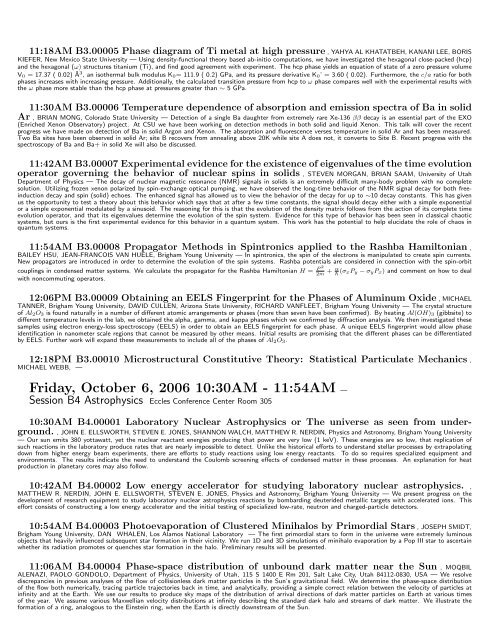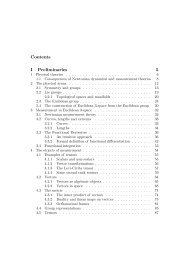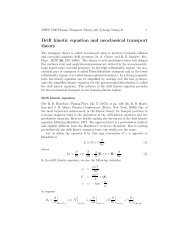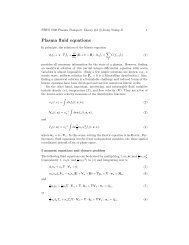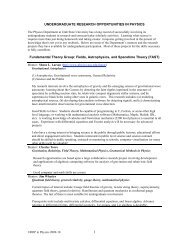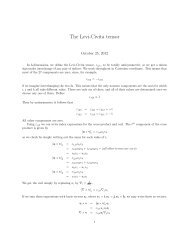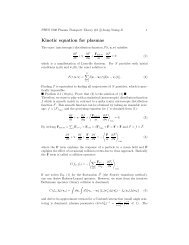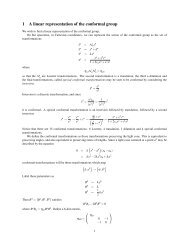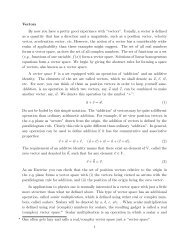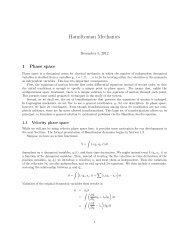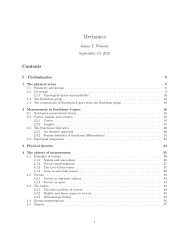second - Physics Department - Utah State University
second - Physics Department - Utah State University
second - Physics Department - Utah State University
Create successful ePaper yourself
Turn your PDF publications into a flip-book with our unique Google optimized e-Paper software.
11:18AM B3.00005 Phase diagram of Ti metal at high pressure , YAHYA AL KHATATBEH, KANANI LEE, BORIS<br />
KIEFER, New Mexico <strong>State</strong> <strong>University</strong> — Using density-functional theory based ab-initio computations, we have investigated the hexagonal close-packed (hcp)<br />
and the hexagonal (ω) structures titanium (Ti), and find good agreement with experiment. The hcp phase yields an equation of state of a zero pressure volume<br />
V 0 = 17.37 ( 0.02) Å 3 , an isothermal bulk modulus K 0 = 111.9 ( 0.2) GPa, and its pressure derivative K 0 ’ = 3.60 ( 0.02). Furthermore, the c/a ratio for both<br />
phases increases with increasing pressure. Additionally, the calculated transition pressure from hcp to ω phase compares well with the experimental results with<br />
the ω phase more stable than the hcp phase at pressures greater than ∼ 5 GPa.<br />
11:30AM B3.00006 Temperature dependence of absorption and emission spectra of Ba in solid<br />
Ar , BRIAN MONG, Colorado <strong>State</strong> <strong>University</strong> — Detection of a single Ba daughter from extremely rare Xe-136 ββ decay is an essential part of the EXO<br />
(Enriched Xenon Observatory) project. At CSU we have been working on detection methods in both solid and liquid Xenon. This talk will cover the recent<br />
progress we have made on detection of Ba in solid Argon and Xenon. The absorption and fluorescence verses temperature in solid Ar and has been measured.<br />
Two Ba sites have been observed in solid Ar; site B recovers from annealing above 20K while site A does not, it converts to Site B. Recent progress with the<br />
spectroscopy of Ba and Ba+ in solid Xe will also be discussed.<br />
11:42AM B3.00007 Experimental evidence for the existence of eigenvalues of the time evolution<br />
operator governing the behavior of nuclear spins in solids , STEVEN MORGAN, BRIAN SAAM, <strong>University</strong> of <strong>Utah</strong><br />
<strong>Department</strong> of <strong>Physics</strong> — The decay of nuclear magnetic resonance (NMR) signals in solids is an extremely difficult many-body problem with no complete<br />
solution. Utilizing frozen xenon polarized by spin-exchange optical pumping, we have observed the long-time behavior of the NMR signal decay for both freeinduction<br />
decay and spin (solid) echoes. The enhanced signal has allowed us to view the behavior of the decay for up to ∼10 decay constants. This has given<br />
us the opportunity to test a theory about this behavior which says that at after a few time constants, the signal should decay either with a simple exponential<br />
or a simple exponential modulated by a sinusoid. The reasoning for this is that the evolution of the density matrix follows from the action of its complete time<br />
evolution operator, and that its eigenvalues determine the evolution of the spin system. Evidence for this type of behavior has been seen in classical chaotic<br />
systems, but ours is the first experimental evidence for this behavior in a quantum system. This work has the potential to help elucidate the role of chaos in<br />
quantum systems.<br />
11:54AM B3.00008 Propagator Methods in Spintronics applied to the Rashba Hamiltonian ,<br />
BAILEY HSU, JEAN-FRANCOIS VAN HUELE, Brigham Young <strong>University</strong> — In spintronics, the spin of the electrons is manipulated to create spin currents.<br />
New propagators are introduced in order to determine the evolution of the spin systems. Rashba potentials are considered in connection with the spin-orbit<br />
couplings in condensed matter systems. We calculate the propagator for the Rashba Hamiltonian H = P 2<br />
2m + ᾱ (σxPy − σyPx) and comment on how to deal<br />
h<br />
with noncommuting operators.<br />
12:06PM B3.00009 Obtaining an EELS Fingerprint for the Phases of Aluminum Oxide , MICHAEL<br />
TANNER, Brigham Young <strong>University</strong>, DAVID CULLEN, Arizona <strong>State</strong> <strong>University</strong>, RICHARD VANFLEET, Brigham Young <strong>University</strong> — The crystal structure<br />
of Al 2 O 3 is found naturally in a number of different atomic arrangements or phases (more than seven have been confirmed). By heating Al(OH) 3 (gibbsite) to<br />
different temperature levels in the lab, we obtained the alpha, gamma, and kappa phases which we confirmed by diffraction analysis. We then investigated these<br />
samples using electron energy-loss spectroscopy (EELS) in order to obtain an EELS fingerprint for each phase. A unique EELS fingerprint would allow phase<br />
identification in nanometer scale regions that cannot be measured by other means. Initial results are promising that the different phases can be differentiated<br />
by EELS. Further work will expand these measurements to include all of the phases of Al 2 O 3 .<br />
12:18PM B3.00010 Microstructural Constitutive Theory: Statistical Particulate Mechanics ,<br />
MICHAEL WEBB, —<br />
Friday, October 6, 2006 10:30AM - 11:54AM —<br />
Session B4 Astrophysics Eccles Conference Center Room 305<br />
10:30AM B4.00001 Laboratory Nuclear Astrophysics or The universe as seen from underground.<br />
, JOHN E. ELLSWORTH, STEVEN E. JONES, SHANNON WALCH, MATTHEW R. NERDIN, <strong>Physics</strong> and Astronomy, Brigham Young <strong>University</strong><br />
— Our sun emits 380 yottawatt, yet the nuclear reactant energies producing that power are very low (1 keV). These energies are so low, that replication of<br />
such reactions in the laboratory produce rates that are nearly impossible to detect. Unlike the historical efforts to understand stellar processes by extrapolating<br />
down from higher energy beam experiments, there are efforts to study reactions using low energy reactants. To do so requires specialized equipment and<br />
environments. The results indicate the need to understand the Coulomb screening effects of condensed matter in these processes. An explanation for heat<br />
production in planetary cores may also follow.<br />
10:42AM B4.00002 Low energy accelerator for studying laboratory nuclear astrophysics. ,<br />
MATTHEW R. NERDIN, JOHN E. ELLSWORTH, STEVEN E. JONES, <strong>Physics</strong> and Astronomy, Brigham Young <strong>University</strong> — We present progress on the<br />
development of research equipment to study laboratory nuclear astrophysics reactions by bombarding deuterided metallic targets with accelerated ions. This<br />
effort consists of constructing a low energy accelerator and the initial testing of specialized low-rate, neutron and charged-particle detectors.<br />
10:54AM B4.00003 Photoevaporation of Clustered Minihalos by Primordial Stars , JOSEPH SMIDT,<br />
Brigham Young <strong>University</strong>, DAN WHALEN, Los Alamos National Laboratory — The first primordial stars to form in the universe were extremely luminous<br />
objects that heavily influenced subsequent star formation in their vicinity. We run 1D and 3D simulations of minihalo evaporation by a Pop III star to ascertain<br />
whether its radiation promotes or quenches star formation in the halo. Preliminary results will be presented.<br />
11:06AM B4.00004 Phase-space distribution of unbound dark matter near the Sun , MOQBIL<br />
ALENAZI, PAOLO GONDOLO, <strong>Department</strong> of <strong>Physics</strong>, <strong>University</strong> of <strong>Utah</strong>, 115 S 1400 E Rm 201, Salt Lake City, <strong>Utah</strong> 84112-0830, USA — We resolve<br />
discrepancies in previous analyses of the flow of collisionless dark matter particles in the Sun’s gravitational field. We determine the phase-space distribution<br />
of the flow both numerically, tracing particle trajectories back in time, and analytically, providing a simple correct relation between the velocity of particles at<br />
infinity and at the Earth. We use our results to produce sky maps of the distribution of arrival directions of dark matter particles on Earth at various times<br />
of the year. We assume various Maxwellian velocity distributions at infinity describing the standard dark halo and streams of dark matter. We illustrate the<br />
formation of a ring, analogous to the Einstein ring, when the Earth is directly downstream of the Sun.


